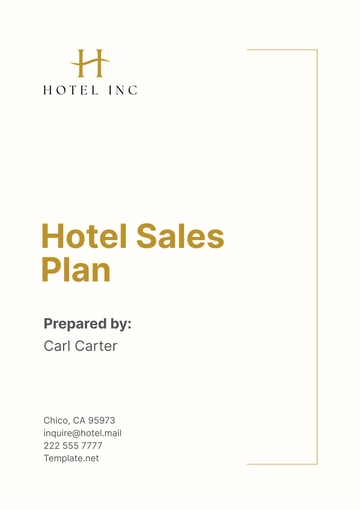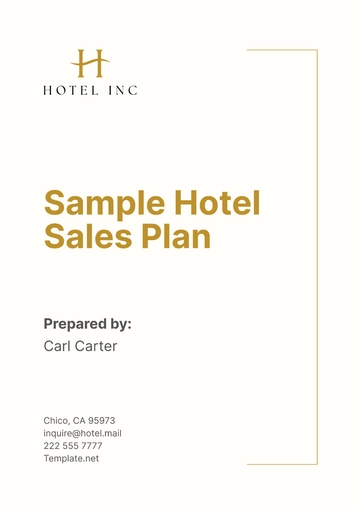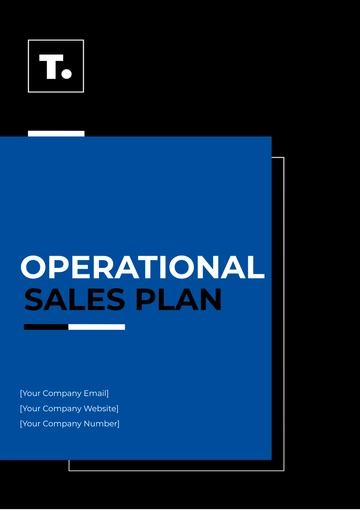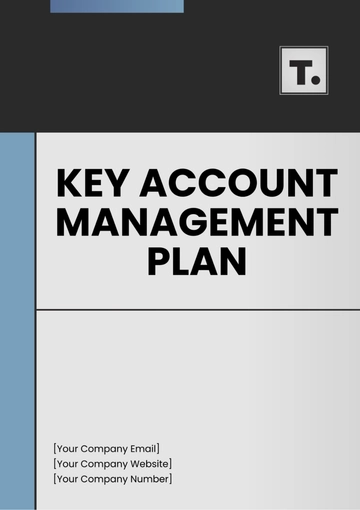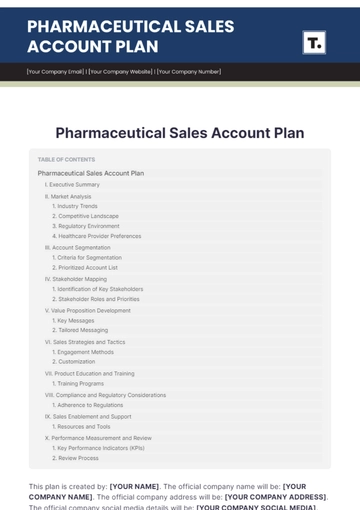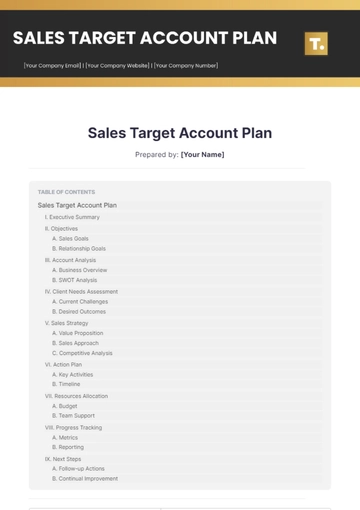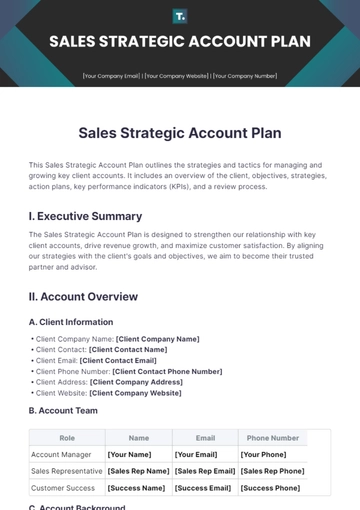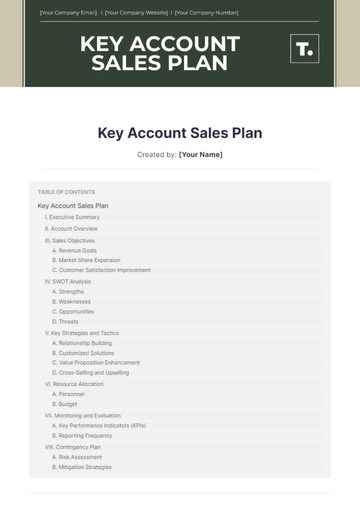Free Saas Sales Compensation Plan

Prepared By: | [Your Name] |
Department: | [Your Department] |
Date: | [Date] |
I. Introduction
A. Purpose of the Plan
This SaaS Sales Compensation Plan establishes a clear framework for rewarding sales team performance in selling our SaaS products. It aligns sales efforts with company goals, motivates our sales force, and ensures fairness in compensation.
B. Overview of Sales Compensation Philosophy
We reward sales performance that drives company growth and customer satisfaction, fostering a customer-centric approach. Our philosophy attracts top talent, retains high performers, and promotes collaboration for excellence.
C. Key Objectives
Drive Sales Performance: Encourage sales representatives to meet and exceed sales targets through a competitive and motivating compensation structure.
Align with Company Goals: Ensure that sales goals are aligned with overall company objectives, such as revenue growth, market expansion, and customer retention.
Reward Achievement: Recognize and reward outstanding performance through fair and transparent commission, bonus, and incentive programs.
Promote Collaboration: Foster teamwork and collaboration among sales teams, departments, and key stakeholders to maximize sales opportunities and customer satisfaction.
Compliance and Ethics: Ensure that all compensation practices adhere to legal requirements, industry standards, and ethical guidelines, promoting trust and integrity within the organization.
II. Sales Roles and Responsibilities
1. Sales Representative
Primary Responsibilities: Actively prospect and qualify leads, conduct product demonstrations, negotiate contracts, and close sales deals.
Key Tasks:
Engage with potential customers to understand their needs and present relevant solutions.
Utilize CRM tools to track leads, manage pipelines, and report sales activities.
Collaborate with marketing teams to align messaging and campaigns with sales efforts.
Provide post-sale support and maintain customer relationships to ensure satisfaction and repeat business.
2. Sales Manager
Primary Responsibilities: Lead and manage the sales team, develop sales strategies, set targets, and monitor performance metrics.
Key Tasks:
Recruit, train, and mentor sales representatives to ensure a high-performing team.
Analyze sales data to identify trends, opportunities, and areas for improvement.
Collaborate with other departments (such as marketing, and product development) to align strategies and achieve company objectives.
Conduct regular sales meetings, and performance reviews, and provide coaching to drive team success.
3. Sales Support/Technical Sales
Primary Responsibilities: Provide technical expertise and support to sales teams and customers during the sales process.
Key Tasks:
Assist sales representatives in understanding technical aspects of products/services and addressing customer inquiries.
Collaborate with product development teams to communicate customer feedback and improve product offerings.
Conduct product demonstrations, and technical presentations, and assist in solution architecture for complex sales opportunities.
Provide ongoing technical support to customers post-sale and ensure smooth implementation and integration processes.
III. Compensation Structure
1. Base Salary
Description: The fixed amount of compensation paid to sales team members regardless of their sales performance.
Purpose: Provides financial stability and acts as a foundation for overall earnings.
Determination: Based on factors such as experience, role level, and market standards for similar positions.
2. Commission Rates
Description: Variable compensation tied directly to sales performance, typically based on a percentage of sales revenue generated.
Purpose: Motivates sales representatives to achieve and exceed sales targets, directly linking effort to reward.
Structure: Commission rates may vary by product/service sold, sales volume, or sales tier levels.
Calculation: Calculated as a percentage of the sales revenue generated by the sales representative.
3. Bonus Structure
Description: Additional compensation beyond base salary and commissions, awarded for achieving specific performance targets or milestones.
Purpose: Rewards exceptional performance, incentivizes goal achievement, and reinforces desired behaviors.
Types of Bonuses:
Quarterly/Annual Performance Bonuses: Based on meeting or exceeding sales targets over specific periods.
Signing Bonuses: Offered for securing new contracts or clients.
Retention Bonuses: These are given to maintain long-term client relationships or meet retention goals.
4. Incentives
Description: Additional rewards or perks offered to sales team members beyond monetary compensation.
Purpose: Enhances motivation, engagement, and loyalty among sales representatives.
Examples:
Performance-Based Rewards: Recognition, awards, or trips for top performers.
Sales Contests/Challenges: Competitions with rewards for achieving specific sales goals.
Professional Development Opportunities: Training programs, certifications, or career advancement paths tied to performance.
IV. Performance Metrics
1. Monthly/Quarterly Sales Targets
Definition: Specific sales goals set for individual sales representatives or teams on a monthly or quarterly basis.
Purpose: Measures productivity, tracks progress towards revenue goals, and drives sales performance.
Calculation: Targets can be based on revenue, units sold, or other relevant metrics depending on the sales role and business objectives.
2. Customer Acquisition Rate
Definition: The rate at which new customers are acquired within a specified period.
Purpose: Indicates the effectiveness of sales and marketing strategies in attracting and converting new leads into customers.
Calculation: (Number of new customers acquired / Total number of prospects) x 100%
3. Revenue Generated per Sales Rep
Definition: The average amount of revenue generated by each sales representative over a defined period.
Purpose: Measures individual sales performance and productivity in revenue generation.
Calculation: Total Sales Revenue Generated by Sales Rep / Number of Sales Reps
4. Customer Retention Rate
Definition: The percentage of customers retained over a specific period, typically annually.
Purpose: Reflects customer satisfaction, loyalty, and the effectiveness of post-sales support and relationship management efforts.
Calculation: ((Number of Customers at End of Period - Number of New Customers Acquired) / Number of Customers at Start of Period) x 100%
Additional Metrics:
Average Sales Cycle Length: Measures the average time it takes to convert leads into customers.
Conversion Rates: Tracks the percentage of leads or prospects that convert into actual sales.
Upsell/Cross-sell Revenue: Measures additional revenue generated through upselling or cross-selling to existing customers.
V. Quota and Targets
Sales Role | Sales Quota | Territory Assignments | Target Achievement Levels |
|---|---|---|---|
Sales Representative | $X per quarter | Geographical or customer segment basis | Min: 80% of $X, Target: 100% of $X, Stretch: 120% of $X |
Sales Manager | $Y per year | Based on team size and market potential | Min: 90% of $Y, Target: 100% of $Y, Stretch: Over 110% of $Y |
Sales Support/Technical | $Z per month | Focus on sales support | Min: Achieve support goals, Target: Meet satisfaction metrics, Stretch: Identify upselling prospects |
VI. Payout Structure
1. Calculation of Commissions and Bonuses
Commissions Calculation: Commissions are calculated as a percentage of the sales revenue generated by the sales representative. The formula typically involves multiplying the sales amount by the commission rate.
Bonus Calculation: Bonuses are calculated based on specific performance metrics such as achieving sales targets, acquiring new customers, or meeting retention goals. The bonus amount may be fixed or variable based on performance levels.
2. Frequency of Payments
Frequency: Payments are typically made on a monthly or quarterly basis, aligning with sales performance reporting cycles.
Commission Payments: Commissions are usually paid out shortly after the end of the reporting period for which they are calculated.
Bonus Payments: Bonuses may be paid out quarterly, semi-annually, or annually, depending on the bonus structure and achievement criteria.
3. Bonus Eligibility Criteria
Sales Targets: Eligibility for bonuses is often tied to achieving or exceeding sales targets set for the respective period (monthly, quarterly, or annually).
Customer Acquisition/Retention: Bonuses may also be tied to metrics such as acquiring new customers, retaining existing customers, or achieving specific revenue milestones.
Performance Metrics: Meeting or exceeding key performance indicators (KPIs) such as sales quotas, revenue targets, and customer satisfaction scores may determine bonus eligibility.
Tenure and Contribution: Longevity with the company, consistent performance, and contributions beyond sales numbers (like team leadership, and mentoring) may also be factors for bonus eligibility.
VII. Policies and Compliance
1. Legal Considerations
Labor Laws: Ensure compliance with local labor laws regarding employee compensation, working hours, overtime pay, and benefits.
Taxation: Adhere to tax regulations regarding employee income, commissions, and bonuses. Provide necessary tax documentation and reporting.
2. Confidentiality and Non-Disclosure Agreements
Confidentiality: Sales team members must maintain confidentiality regarding company information, customer data, and proprietary sales strategies.
Non-Disclosure Agreements (NDAs): Ensure that sales representatives sign NDAs to protect sensitive company information and intellectual property.
3. Ethics and Conduct Guidelines
Ethical Sales Practices: Emphasize ethical behavior in sales interactions, including honesty, transparency, and fair treatment of customers.
Conduct Guidelines: Define expected conduct regarding conflicts of interest, bribery, and adherence to company policies and values.
VIII. Communication and Review
1. Communication Plan for Rolling Out the Plan
Announcement: Communicate the new compensation plan to sales teams through meetings, emails, and training sessions.
Documentation: Provide written materials outlining plan details, including compensation structures, performance metrics, and eligibility criteria.
Q&A Sessions: Conduct question-and-answer sessions to address any queries or concerns from sales team members.
2. Regular Review and Adjustments
Frequency: Schedule quarterly and annual reviews of the compensation plan to evaluate effectiveness and alignment with company goals.
Performance Analysis: Analyze sales performance data, feedback from sales teams, and market trends to identify areas for improvement or adjustments to quotas, targets, or incentives.
Policy Updates: Update policies and guidelines as needed to reflect changes in legal requirements, market conditions, or company strategies.
3. Feedback Mechanisms for the Sales Team
Surveys and Interviews: Gather feedback through surveys, one-on-one interviews, or focus groups to understand sales team perceptions, challenges, and suggestions for improvement.
Regular Check-Ins: Schedule regular check-ins between sales managers and team members to discuss progress, address concerns, and provide coaching or support as needed.
- 100% Customizable, free editor
- Access 1 Million+ Templates, photo’s & graphics
- Download or share as a template
- Click and replace photos, graphics, text, backgrounds
- Resize, crop, AI write & more
- Access advanced editor
Optimize your compensation strategy with Template.net's SaaS Sales Compensation Plan Template. This editable and customizable template is designed for SaaS businesses to manage sales incentives effectively. Editable in our AI Editor Tool, it provides flexibility to adjust compensation structures as needed. Enhance your sales team's motivation and productivity with this essential and comprehensive compensation plan tailored for SaaS sales success.
You may also like
- Finance Plan
- Construction Plan
- Sales Plan
- Development Plan
- Career Plan
- Budget Plan
- HR Plan
- Education Plan
- Transition Plan
- Work Plan
- Training Plan
- Communication Plan
- Operation Plan
- Health And Safety Plan
- Strategy Plan
- Professional Development Plan
- Advertising Plan
- Risk Management Plan
- Restaurant Plan
- School Plan
- Nursing Home Patient Care Plan
- Nursing Care Plan
- Plan Event
- Startup Plan
- Social Media Plan
- Staffing Plan
- Annual Plan
- Content Plan
- Payment Plan
- Implementation Plan
- Hotel Plan
- Workout Plan
- Accounting Plan
- Campaign Plan
- Essay Plan
- 30 60 90 Day Plan
- Research Plan
- Recruitment Plan
- 90 Day Plan
- Quarterly Plan
- Emergency Plan
- 5 Year Plan
- Gym Plan
- Personal Plan
- IT and Software Plan
- Treatment Plan
- Real Estate Plan
- Law Firm Plan
- Healthcare Plan
- Improvement Plan
- Media Plan
- 5 Year Business Plan
- Learning Plan
- Marketing Campaign Plan
- Travel Agency Plan
- Cleaning Services Plan
- Interior Design Plan
- Performance Plan
- PR Plan
- Birth Plan
- Life Plan
- SEO Plan
- Disaster Recovery Plan
- Continuity Plan
- Launch Plan
- Legal Plan
- Behavior Plan
- Performance Improvement Plan
- Salon Plan
- Security Plan
- Security Management Plan
- Employee Development Plan
- Quality Plan
- Service Improvement Plan
- Growth Plan
- Incident Response Plan
- Basketball Plan
- Emergency Action Plan
- Product Launch Plan
- Spa Plan
- Employee Training Plan
- Data Analysis Plan
- Employee Action Plan
- Territory Plan
- Audit Plan
- Classroom Plan
- Activity Plan
- Parenting Plan
- Care Plan
- Project Execution Plan
- Exercise Plan
- Internship Plan
- Software Development Plan
- Continuous Improvement Plan
- Leave Plan
- 90 Day Sales Plan
- Advertising Agency Plan
- Employee Transition Plan
- Smart Action Plan
- Workplace Safety Plan
- Behavior Change Plan
- Contingency Plan
- Continuity of Operations Plan
- Health Plan
- Quality Control Plan
- Self Plan
- Sports Development Plan
- Change Management Plan
- Ecommerce Plan
- Personal Financial Plan
- Process Improvement Plan
- 30-60-90 Day Sales Plan
- Crisis Management Plan
- Engagement Plan
- Execution Plan
- Pandemic Plan
- Quality Assurance Plan
- Service Continuity Plan
- Agile Project Plan
- Fundraising Plan
- Job Transition Plan
- Asset Maintenance Plan
- Maintenance Plan
- Software Test Plan
- Staff Training and Development Plan
- 3 Year Plan
- Brand Activation Plan
- Release Plan
- Resource Plan
- Risk Mitigation Plan
- Teacher Plan
- 30 60 90 Day Plan for New Manager
- Food Safety Plan
- Food Truck Plan
- Hiring Plan
- Quality Management Plan
- Wellness Plan
- Behavior Intervention Plan
- Bonus Plan
- Investment Plan
- Maternity Leave Plan
- Pandemic Response Plan
- Succession Planning
- Coaching Plan
- Configuration Management Plan
- Remote Work Plan
- Self Care Plan
- Teaching Plan
- 100-Day Plan
- HACCP Plan
- Student Plan
- Sustainability Plan
- 30 60 90 Day Plan for Interview
- Access Plan
- Site Specific Safety Plan













